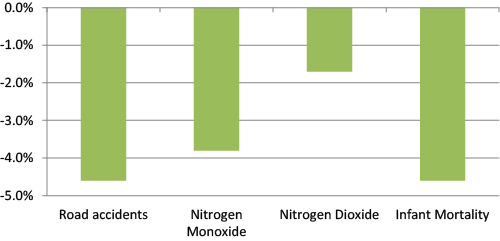Road accidents kill 1.2m people every year (WHO). Road transportation is the main source of local air pollutants such as nitrogen oxide and carbon monoxide. It contributes to noise and global air pollution, and it leads to congestion. Against this backdrop, many governments subsidise railways with the explicit aim of reducing road-traffic externalities. However, do improvements in public transport really curb road-traffic externalities? In this column, we discuss recent empirical evidence identifying positive effects of public-transport improvements.
Better public transport
Better public transport reduces traffic externalities if people use trains rather than cars, and if trains are less polluting than cars. Neither of these conditions needs to be fulfilled. Even if better public transport attracts more passengers, road transportation is not necessarily reduced. Rather, the improvements in public transport may create even more traffic. Although, on average, transporting a passenger by public transport generates less pollution than transporting a passenger by car, it is less clear whether additional trains lead to less pollution than the cars they replace. Therefore it is ultimately an empirical question as to whether public-transport improvements reduce road-traffic externalities.
Measuring the effects of public-transport improvements
How can we estimate the effects of public-transport improvements? The challenge is to isolate policy effects from underlying trends. This is not a trivial matter, since authorities spend more on railways in places where they expect more traffic and thus deteriorating road safety and environmental quality. Any positive effects of public-transport expansions may be obscured by adverse underlying trends.
There are at least two ways to separate the effects of better railway services from those of other factors:
- First, study abrupt changes in numbers of passengers brought about by the opening of new public-transport schemes, isolating the effect of these new schemes from the smoothly changing effects of other factors;
- Second, exploit large changes in railway-service frequency caused by factors that are unrelated to road traffic development.
The first approach is especially attractive in countries that are in the process of establishing public transport for the first time. In a recent paper, Chen and Whalley (2012) show that the large discontinuous increase in numbers of passengers on the opening day of the Taipei metro reduced carbon monoxide and nitrogen oxide pollution, although the latter effect is imprecisely estimated. This is a first piece of evidence that expansions of public transport can improve air quality. But how informative are these findings for Western countries with generally well-established public-transport systems, high road safety and environmental quality? Are such results also obtained for incremental rather than radical changes in public-transport schemes?
Our approach
In a recent paper (Lalive et al. 2013), we argue that a specific railway reform in the mid-nineties in Germany provides a rare opportunity to apply the second approach. We study how improvements in regional passenger-railway frequency affect road-traffic externalities. The railway reform enabled newly created regional agencies to procure regional passenger lines competitively. As a result of the reform, some regional passenger-railway lines were procured in competitive auctions and others in direct negotiations with the incumbent supplier. Most importantly for us, competitively procured lines experienced much larger increases in service frequency than non-competitively procured lines. While the decision on the procurement mode is not random, it is unrelated to pre-existing levels and trends in road-traffic externalities and voter preferences. Moreover, the decision makers differ from those of other transport and environmental policies, and the decision on the procurement mode has no implications for ticket prices or other aspects of service quality. This makes us confident that improvements in railway service caused by competitive procurement are unrelated to the evolution of road traffic – this is the key condition to apply the second approach.
We collected data on the frequency of service on 551 regional passenger lines before the reform and then again a decade later, together with information on severe road traffic accidents, concentrations of local air pollutants, and infant mortality. Using these data, we find no correlation between service frequency growth and changes in road-traffic externalities. This is consistent with the notion that positive effects are obscured by adverse underlying trends. However, if we exploit the large increase in service frequency on competitively procured lines to identify the effects on road-traffic externalities, a very different picture emerges: an increase in service frequency by 10% reduces accidents by 4.6%, and nitrogen monoxide and nitrogen dioxide concentrations by 3.8% and 1.7%, respectively (see Figure 1). Do these improvements in air quality entail beneficial health effects? Our results suggest this to be the case. We find that an increase in service frequency by 10% reduces infant mortality rates by 4.6%.
Figure 1. The environmental benefits of railroads: Effect of 10% increase in rail frequency
With survey data on the use of different transport modes, we also analyse the household decisions driving our results. We find that an increase in service frequency by 10% reduces car and motorcycle use for commuting to work by 2.7 percentage points and by 2.8 percentage points for leisure trips. Estimates are negative but smaller and imprecise for shopping, weekend trips, and taking children to school. These findings indicate that people indeed substitute from cars to trains if passenger service frequency increases. Interestingly, service frequency growth is not related to sulphur dioxide or ground-level ozone. This is reassuring because sulphur dioxide is emitted by large stationary sources such as power plants and the complex chemistry of ozone formation leads to high concentrations far away from the emission sources of its precursors.
Conclusions
In sum, recent empirical evidence on public-transport improvements confirms expectations of beneficial effects on road safety and environmental quality. Moreover, conservative back-of-the-envelope calculations that do not take reductions in congestion, noise and greenhouse gases into account suggest that public-transport improvements offer good value for money. Improvements in rail service frequency reduce external traffic costs worth as much as the costs associated with their implementation.
References
Chen, Yihsu and Alexander Whalley (2012), “Green infrastructure: The effects of urban rail transit on air quality”, American Economic Journal: Economic Policy 4(1), 58-97.
Lalive, Rafael, Simon Luechinger, and Armin Schmutzler (2013), “Does supporting passenger railroads reduce road transportation externalities?”, CEPR Discussion Paper 9335, London, Centre for Economic Policy Research.






